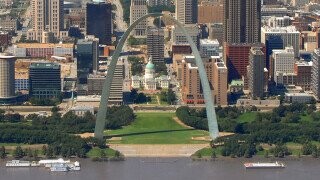The Plan To Move The White House And Capitol To St. Louis (By Train)

We asked readers which city they advise people to steer clear of. This gave everyone the chance to both trash cities for their flaws ("Albuquerque," says Cinnamon D., "Come for the balloon fiesta, stay because your car was stolen") and protect their own cities from invasion ("Any city in Colorado," says Brandon H. "We're full").
A fair number of you had bad things to say about St. Louis. "Basically think Detroit in Robocop, without the nice parts," said Jacob S. Erica B. and Ginger R. called out the city as cold and unfriendly, while Aaron S. said plenty of people are fleeing St. Louis for greener pastures in Kansas City.
St. Louis might have ended up with a higher profile than it has right now. Soon after the Civil War, Congress was considering moving the nation's capital from Washington to St. Louis. The reasoning was simple: Washington, D.C. might have made sense as the capital back in 1790, when it was considered a nice central location between the north and the south. But the country had expanded far westward since then, and the best way to unify the nation now was to have a capital somewhere truly in the new middle.
Don't Miss
Now, we're not going to laugh at a young country thinking of picking a new capital city a hundred years in. Plenty of countries have done that. The funny part is the specifics of the plan, first suggested by St. Louis businessman Logan Uriah Reavis in 1846 and then revived decades later. Reavis thought that shifting the capital meant shifting the Capitol—the physical Capitol building.
Reavis created a plan to disassemble the building into blocks, transport them by train to Missouri, and then reconstruct it in St. Louis. Same deal with the White House and several other federal buildings. You might think it would be easier to construct new buildings in St. Louis from scratch, but continuity was important when it came to selling people on the move.
Other reasons for shifting the capital included the mosquitos that infested D.C., the humidity there, and how St. Louis was a more major city with over twice the population. In 1868, the plan actually made it to a vote in the House. It lost, but not by that much—77 voted for it, and 97 voted against it. People in St. Louis who owned a lot of real estate cursed the missed opportunity to see the value of their land soar, while others in St. Louis sighed in relief knowing that they'd be spared an influx of politicians.
This fact came from the One Cracked Fact newsletter. Want more like this, straight from your email inbox, without any ads or popups? Join here:
For more on the Gateway to the West, check out:
Missouri's Bizarre Modern-Day Lovecraftian Beauty Pageant
6 Ways the 1904 Olympics Were the Craziest Event Ever Held
6 Places Where You Can Visit the Post-Apocalypse (Today)
Follow Ryan Menezes on Twitter for more stuff no one should see.
Top image: Timothy Reinhart
